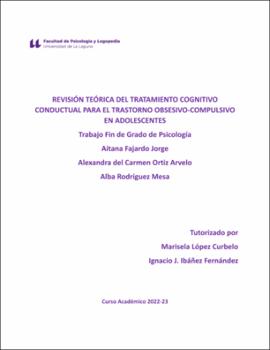Revisión teórica del tratamiento cognitivo conductual para el trastorno obsesivo-compulsivo en adolescentes
Fecha
2023Resumen
El trastorno obsesivo compulsivo (TOC) es el cuarto trastorno psicopatológico más común en el
mundo, con una prevalencia del 1 al 3 % de la población, el cual provoca un gran impacto
biopsicosocial. Las dos principales vías de tratamiento son el farmacológico y la terapia
cognitivo conductual (TCC). Este último se caracteriza por ser un tratamiento breve, directivo,
estar orientado a objetivos, centrarse en la modificación de cogniciones y conductas, y por
utilizar frecuentemente “tareas para casa”. A lo largo del trabajo, y como objetivo del mismo, se
intentará responder de forma más detallada a la incógnita sobre cuáles son las distintas formas
de aplicar la terapia cognitivo conductual (TCC), el nivel de adecuación de la TCC como
tratamiento para el TOC en adolescentes y su eficacia comparada con otros tratamientos.
Además, se buscará mostrar las características principales de los adolescentes diagnosticados
con TOC. Obsessive compulsive disorder (OCD) is the fourth most common psychopathological disorder
in the world, with a prevalence of 1-3 % of the population, which has a major biopsychosocial
impact. The two main avenues of treatment are pharmacological and cognitive behavioural
therapy (CBT). The latter is characterised by being brief, directive, goal-oriented, focusing on
cognitive and behavioural modification, and frequently using "homework". The aim of this paper
is to provide a more detailed answer to the question of what are the different ways of applying
cognitive behavioural therapy (CBT), the appropriateness of CBT as a treatment for OCD in
adolescents and its efficacy compared to other treatments. In addition, it will seek to show the
main characteristics of adolescents diagnosed with OCD.





